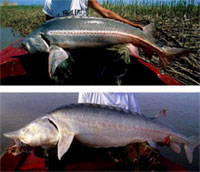|
For use of the media only;
not an official document.
PRESS RELEASE
CITES authorizes sturgeon export quotas for the Black Sea
Geneva, 7 September 2004 – The Secretariat of the Convention on International Trade in Wild Species of Fauna and Flora (CITES) has today published the 2004 export quotas for three Black Sea countries that jointly manage the sturgeon stocks that spawn every year in the Danube River.
The quotas permit Romania to export 3,410 kg of caviar; Bulgaria to export 1,720 kg of caviar and Serbia and Montenegro to export 700 kg of caviar. These countries also plan to export a combined total of 23,000 kg of sturgeon meat.
 “Although Black Sea caviar and sturgeon represent a small percentage of the global trade in these valuable wildlife products, it is encouraging that these sturgeon range States have collaborated successfully in order to comply with the conservation requirements that governments must now meet before they can obtain their annual quotas,” said CITES Secretary-General Willem Wijnstekers. “Although Black Sea caviar and sturgeon represent a small percentage of the global trade in these valuable wildlife products, it is encouraging that these sturgeon range States have collaborated successfully in order to comply with the conservation requirements that governments must now meet before they can obtain their annual quotas,” said CITES Secretary-General Willem Wijnstekers.
“While several press stories in recent days erroneously stated that CITES has placed a ban on caviar, these first new quotas for 2004 demonstrate that the process in place for establishing quotas is indeed working,” he added.
CITES responded to high levels of poaching and illegal trade in the Caspian Sea – which accounts for some 90% of world caviar – by halting the trade in Caspian caviar in 2001. It gave the governments of Azerbaijan, Kazakhstan, Russia and Turkmenistan until the end of that year to conduct a scientific survey of stocks and to start developing a common management plan. The fifth Caspian State, Iran, was not subject to the caviar ban, but, commendably, it too joined the regional effort.
This so-called ‘Paris Agreement’ established three deadlines for taking steps that would lead to the resumption of trade. Because the various anti-poaching and other actions specified in the first two deadlines were met, CITES agreed to sturgeon and caviar trade quotas for the Caspian States in 2002 and 2003.
Then, in November 2002, the member Governments of CITES developed a list of conservation measures that now apply to all of the world’s sturgeons. These measures were derived from the obligations detailed in the Paris Agreement and were formalized in Resolution Conf. 12.7.
To comply with the requirements of this Resolution, the Black Sea countries developed common management plans. They are committed to ensuring that all catch and export quotas are based on these plans and on annual stock assessments.
Importantly, the CITES Secretariat cannot publish a country’s annual quotas unless it is satisfied that this country as well as the other States with which it shares stocks have complied fully with the requirements of the Resolution.
The Secretariat looks forward to receiving the required information from the world’s other shared sturgeon basins, including the Caspian Sea, the Great Lakes of North America, the Azov Sea and the Amour River so that it can publish additional 2004 sturgeon and caviar export quotas.
Note to journalists: For more information see www.cites.org/eng/resources/quotas/sturgeon_intro.shtml
Or contact Juan-Carlos Vasquez at +41-22-917-8156 (office) or juan.vasquez@unep.ch, or Michael Williams at +41-79-409-1528 (cell), +41-22-917-8242 (office), or michael.williams@unep.ch.
 To read previous press releases, go to Archives. To read previous press releases, go to Archives.
|